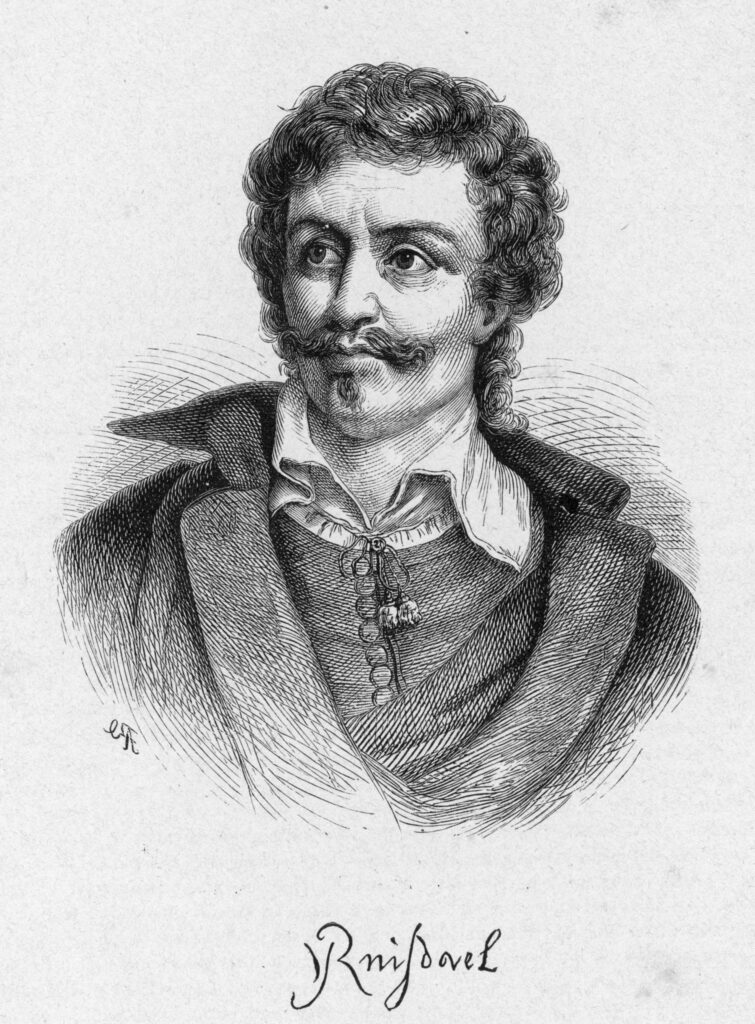
Born: 1628-1629, Haarlem
Died: 10 March 1682 (aged 52-53)
Period: Dutch Golden Age
The Life of Jacob van Ruisdael
Jacob van Ruisdael was one of the most prominent Dutch landscape painters of the 17th century, part of the Golden Age of Dutch art. Born in Haarlem, Netherlands, into a family of artists, Ruisdael was profoundly influenced by his environment and the work of his predecessors, including his father Isaack van Ruysdael, an artist and frame-maker, and his uncle Salomon van Ruysdael, a well-known landscape painter.
Ruisdael’s work encompasses a wide range of natural scenes, including forests, dunes, beaches, and waterfalls, as well as cityscapes and seascapes. He is particularly renowned for his dramatic skies, meticulous detail, and the ability to capture the mood of the Dutch countryside. His landscapes often feature brooding skies, rugged terrain, and derelict structures, evoking a sense of melancholy and the sublime power of nature.
Despite the apparent tranquility and naturalism in his work, Ruisdael’s landscapes are often carefully constructed compositions that reflect the artist’s profound understanding of nature and his ability to manipulate elements for dramatic effect. His paintings, such as “The Windmill at Wijk bij Duurstede” and “View of Haarlem with Bleaching Grounds,” are celebrated for their technical mastery and depth of expression, contributing significantly to the landscape genre’s development.
Ruisdael’s work achieved considerable acclaim during his lifetime, and he was a member of the Haarlem painters’ guild. However, details about his personal life are scarce, and he is believed to have led a relatively quiet life, dedicated to his art. He never married and had no known children. In his later years, Ruisdael moved to Amsterdam, where he continued to paint until his death in 1682.
Today, Jacob van Ruisdael is considered one of the greatest landscape artists of all time, and his work has influenced countless artists, including the Romantics and the Hudson River School painters in the 19th century. His ability to evoke the beauty and majesty of the natural world continues to captivate viewers, securing his place as a pivotal figure in the history of art.
Jacob van Ruisdael’s Notable Works
Jacob van Ruisdael is celebrated for his profound influence on the landscape genre, creating works that capture the essence and beauty of the Dutch countryside with unparalleled skill. Here are ten of his most famous and influential works, showcasing his mastery of atmosphere, detail, and the dramatic interplay of light and shadow:
- The Windmill at Wijk bij Duurstede (c. 1670) – This iconic painting is one of Ruisdael’s most celebrated works, depicting a towering windmill against a brooding sky, exemplifying his ability to capture the Dutch landscape’s majesty and the sublime power of nature.
- View of Haarlem with Bleaching Grounds (c. 1670-1675) – Renowned for its expansive view of the city of Haarlem, this painting is praised for its detailed depiction of the linen bleaching fields and the serene beauty of the Dutch countryside.
- Jewish Cemetery (c. 1654-1655) – This work features a dramatic landscape with a ruined cemetery, reflecting themes of decay and the transience of life, imbued with a sense of melancholic beauty and sublime nature.
- The Great Oak (c. 1652) – A testament to Ruisdael’s skill in rendering the intricacies of nature, this painting focuses on a single, majestic oak tree, highlighting the artist’s fascination with trees and their symbolic power.
- Waterfall with Castle Built on the Rock (c. 1665-1670) – Ruisdael painted several waterfall scenes, which are notable for their dynamic representation of water and dramatic landscapes, incorporating fantastical elements alongside precise natural observation.
- The Ray of Light (c. 1660-1670) – This painting is celebrated for its dramatic use of light breaking through the clouds to illuminate the landscape below, showcasing Ruisdael’s mastery of atmospheric effects.
- Two Watermills and an Open Sluice (c. 1650s) – Highlighting Ruisdael’s interest in water as a dynamic element in the landscape, this painting captures the energy and movement of water alongside the serene Dutch countryside.
- Seascape near Haarlem (c. 1670) – Ruisdael’s seascapes, including this one, are admired for their depiction of the turbulent sea, dramatic skies, and the artist’s ability to convey the sea’s overwhelming power and beauty.
- Winter Landscape (c. 1660s) – This work is one of the few winter scenes painted by Ruisdael, offering a stark yet beautiful depiction of the Dutch landscape covered in snow, demonstrating his versatility in capturing the various moods of nature.
- Bentheim Castle (c. 1653) – Part of a series of paintings depicting the German castle, this work exemplifies Ruisdael’s interest in ruins and his ability to integrate architectural elements into the natural landscape harmoniously.
Jacob van Ruisdael’s paintings continue to be celebrated for their emotional depth, technical precision, and the profound sense of awe they evoke for the natural world, securing his legacy as one of the greatest landscape painters in art history.